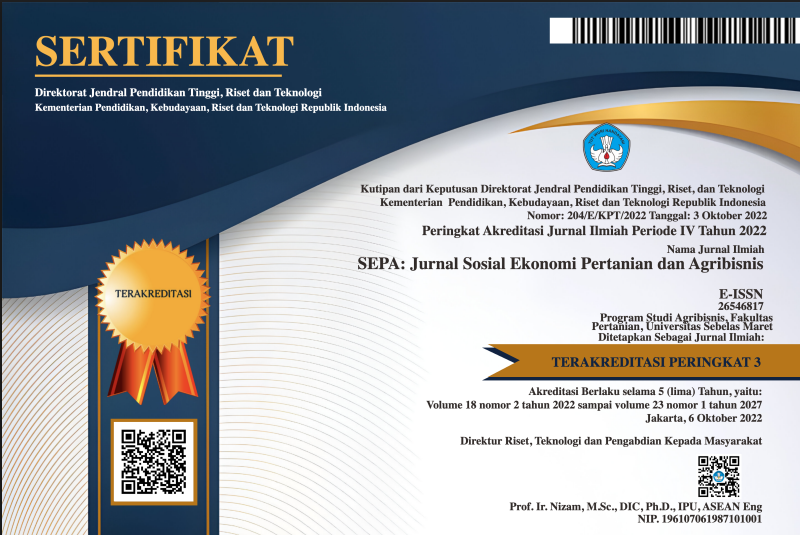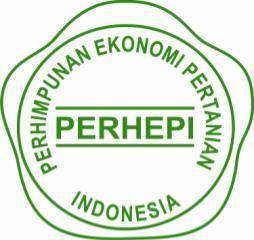SEKTOR PERTANIAN DALAM DINAMIKA TRANSFORMASI STRUKTURAL DI INDONESIA
Abstract
Indonesia is a country that has relied on the agricultural sector as an economic base for decades. On the other hand, the more developed an economy is, the higher the reserves in the service sector. Despite this declining GDP, agriculture is still very important to the Indonesian economy, even though it is 14 percent of GDP. This study analyzes structural transformation through shift-share analysis. It looks at the tendency of labor to enter the agricultural, manufacturing and service sectors using probit regression on Sakernas microdata. This study found that the service sector continues to grow and outperforms the agricultural sector both in terms of added value and employment. The results of the shift-share show shrinkage in the productivity of agricultural sector while the manufacturing and service sectors are growing. This fact proves a change in economic structure. The characteristics of the agricultural sector labor force have a higher tendency for male workers, live in rural areas, are relatively older and have fewer family members, are less educated, do not have training certification, and have no previous work experience.
service sector, agricultural sector, manufacturing sector, probit, structural transformation
Keywords
Full Text:
PDFReferences
Amir, H. (2015). Sektor Pertanian: Perlu Upaya Akselerasi Pertumbuhan. Jakarta: Kementerian Keuangan.
Anandita, Della Ayu & Patria, K.Z. (2016). Agriculture challenges: Decline of farmers and farmland (study from Indonesian Family Life Survey). Jurnal Ilmu Ekonomi dan Pembangunan, 16(1), 48–53.
Asian Development Bank. (2013). Asia’s Economic Transformation Where to, How, and How Fast? Manila: ADB.
Badan Pusat Statistik (BPS). (2018). Survei Angkatan Kerja Nasional. Jakarta: Badan Pusat Statistik
Bah, E. H. (2009). Structural transformation in developed and developing countries. Proceedings of the German Development Economics Conference.
Briones, R., & Felipe, J. (2013). Agriculture and structural transformation in developing Asia. ADB Economics Working Paper Series, 363. Retrieved from https://www.adb.org/sites/default/fi les/publication/30380/ewp-363.pdf.
Clark, C. (1940). The Conditions of Economic Progress. London: MacMillan & Co. Ltd.
Divanbeigi, R., Paustian, N., & Loayza, N. (2016). Structural transformation of the agricultural sector: A Primer. World Bank Research and Policy Briefs, 104231.
Doyle, E. (1997). Structural change in Ireland. Journal of Economic Studies, 24, 58–68.
Fisher, A.G.B. (1935). The Clash of Progress and Security. London: MacMillan & Co. Ltd.
Food and Agricultural Organization. (2018). Small family farms country factsheet. Retrieved from http://www.fao.org/fami ly-farming/detail/en/c/1115197/.
Huffman, W.E. (1980). Farm and off-farm work decisions: The role of human capital The Review of Economics and Statistics, 62(1), 14–23.
Isaksson, A. (2010). Structural change and productivity growth: a review with implications for developing countries. UNIDO Working Paper, 08. Retrieved from https://www.unido.org/ api/open text/documents/download/10081102/unido-file-10081102.
Islam, S. N., & Iversen, K. (2018). From “structural change” to “transformative change”: Rationale and implications. United Nations Working Paper, 155. Retrieved from https://www.un.org/ esa/ desa/papers/2018/wp155_2018.pdf
Kim, H. J. (2006). The Shift to the Service Economy: Causes and Effects. Washington: Institute for Monetary and Economic Research.
Lee, J.W, & McKibbin, W. (2018). Service sector productivity and economic growth in Asia. Economic Modelling, 74, 247–263.
Marjanović, V. (2015). Structural changes and structural transformation in a modern development economy. Economic Themes, 53(1), 63–82.
McMillan, M. S., & Rodrik, D. (2011). Globalization, structural change, and productivity growth. NBER Working Paper, 17143. Retrieved from https:// www.nber.org/papers/w17143.
OECD. (2000). The Service Economy. Paris: Science Technology Industry Business and Industry Policy Forum Series.
Panchamukhi, V. R. (1989). International agricultural trade: Some policy issues. Indian Journal of Agricultural Economics, 44, 399–403.
Pitoyo, A.J. (2007). Dinamika sektor informal di Indonesia prospek, perkembangan, dan kedudukannya dalam sistem ekonomi makro. Populasi, 18(2), 129–146.
Rizov, M. & Swinnen, J. F. M. (2004). Human capital, market imperfections, and labor reallocation in transition, Journal of Comparative Economics, 32(4), 745– 774.
Romli, M. S., Hutagaol, M. P., & Priyarsono, D.S. (2016). Transformasi struktural: Faktor-faktor dan pengaruhnya terhadap disparitas pendapatan di Madura. Jurnal Ekonomi dan Kebijakan Pembangunan, 5(1), 25–44.
Schettkat, R., & Yocarini, L. (2006). The shift to services employment: A review of the literature. Structural change and economic dynamics, 17(2), 127–147.
Szirmai, A. (2012). Industrialisation as an engine of growth in developing countries, 1950–2005. Structural change and economic dynamics, 23(4), 406–420.
Tocco, B., Davidova, S., & Bailey, A. (2012). Key issues in agricultural labour markets: A review of major studies and project reports on agriculture and rural labour markets. Factor Markets Working Paper, 20. Retrieved from http:// aei.pitt. edu/58523/1/Factor_Markets_20.pdf.
Witt, U., & Gross, C. (2020). The rise of the “service economy” in the second half of the twentieth century and its energetic contingencies. Journal of Evolutionary Economics, 30, 231–246.
World Bank. (2018). Definisi nilai tambah (Value Added).Retrieved from https://da tacatalog.worldbank.org/search?query=%20services-value-added-current-us-0.
World Bank. (2020). World development indicators. Retrieved from https://data bank.worldbank.org/source/world-development-indicators.
DOI: https://doi.org/10.20961/sepa.v18i1.45605
Refbacks
- There are currently no refbacks.



.png)







.png)
3.png)





